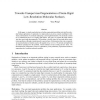Free Online Productivity Tools
i2Speak
i2Symbol
i2OCR
iTex2Img
iWeb2Print
iWeb2Shot
i2Type
iPdf2Split
iPdf2Merge
i2Bopomofo
i2Arabic
i2Style
i2Image
i2PDF
iLatex2Rtf
Sci2ools
GMP
2006
IEEE
2006
IEEE
Towards Unsupervised Segmentation of Semi-rigid Low-Resolution Molecular Surfaces
In this paper, we study a particular type of surface segmentation problem motivated by molecular biology applications. In particular, two input surfaces are given, coarsely modeling two different conformations of a molecule undergoing a semi-rigid deformation. The molecule consists of two subunits that move in a roughly rigid manner. The goal is to segment the input surfaces into these semi-rigid subcomponents. The problem is closely related to non-rigid surface registration problems, although considering only a special type of deformation that exists commonly in macromolecular movements (such as the popular hinge motion). We present and implement an efficient paradigm for this problem, which combines several existing and new ideas. We demonstrate the performance of our new algorithm by some preliminary experimental results in segmenting low-resolution molecular surfaces.
| Added | 11 Jun 2010 |
| Updated | 11 Jun 2010 |
| Type | Conference |
| Year | 2006 |
| Where | GMP |
| Authors | Yusu Wang, Leonidas J. Guibas |
Comments (0)

